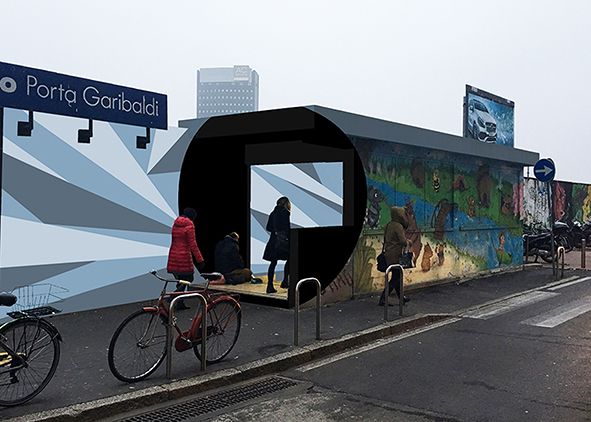Color as temporary tool of urban regeneration
DOI:
https://doi.org/10.19229/2464-9309/4302018Keywords:
color design, urban regeneration, perceptive and social requalification, design of the territory, public artAbstract
The contribution presents the reference framework and the first results of a research aimed at exploring and experimenting intervention strategies and solutions that address the issue of urban regeneration of critical places within the city, enhancing the possibilities to intervene easily, quickly and temporarily through color in a relationship of dialogue with the specificities of the territory and the local identities. Color, a design component transitory by nature and linked to the ‘superficial’ aspects of the existing, presents itself as a privileged tool of intervention, generating results of great visual impact at relatively sustainable costs, in a sensitive and dynamic process of adaptation to the rapid needs that characterize the contemporaneity.
Downloads
Article Metrics Graph
References
Aime, M. (2013), Cultura, Bollati Boringhieri, Torino.
Baule, G., Calabi, D. and Scuri, S. (2014), “Narrare il territorio: Dispositivi e Strategie d’innovazione per gli Spazi Percepiti”, in 5th STS Italia Conference A Matter of Design – Making Society through Science and Technology, 12-14 June 2014, Milan, STS Italia, Milano.
Boeri, C. (2016), Planeamento e projecto da cor urbana, Tesi di dottorato in Architettura, Universidade Lusíada de Lisboa.
Boeri, C. (2017), “Color loci placemaking: The urban color between needs of continuity and renewal”, in Color research and application, vol. 42, n. 5, pp. 641-649.
Boeri, C. (2018), Color loci placemaking – La pianificazione e la progettazione del colore urbano tra continuità e rinnovamento, Maggioli, Santarcangelo di Romagna.
Boeri, C., Calabi, D. and Bisson, M. (2017), “Il contributo del colore all’interno dei processi di rigenerazione urbana”, in Bisson, M. (ed.), Environmental Design: IInd International Conference on Environmental Design, Proceedings (reviewed papers) of the IInd International Conference on Environmental Design, Mediterranean Design Association, 30-31 March 2017, Torino, Italy, De Lettera Publisher, Milano, pp. 379-386.
Gilmore, J. (2013), Philly Painting: A case study. [Online] Available at: www.muralarts.org/wp-content/uploads/2016/03/CaseStudy_FINAL.pdf [Accessed 1 May 2018).
Griffero, T. (2017), Atmosferologia – Estetica degli spazi emozionali, Mimesis Ed., Milano.
Greaney, M. E. (2002), “The Power of the Urban Canvas: Paint, Politics, and Mural Art Policy”, in New England Journal of Public Policy, vol. 18, n. 1, pp. 7-48.
Herdeg K. (1978), “Supergraphics and Animated Walls”, in Herdeg, W. (ed.), Archigraphia – Architectural and Environment graphics, Graphis, Dufourstrasse, pp. 162-215.
Le Corbusier, Polychromie architecturale, in De Heer J. (2009), The Architectonic Colour: Polychromy in the Purist Architecture of Le Corbusier, 010 Publishers, Rotterdam, pp. 224-227.
Lenclos, J. P. (2009), “The Globalization of Colour”, in Porter, T. and Mikellides, B. (eds), Colour for Architecture Today, Taylor & Francis, Laren, pp. 84-86.
McMorrough, J. (2007), “Blowing the Lid off Paint – The Architectural Coverage of Supergraphics”, in Dean, P. (ed.), Rethinking Representation, episode publishers, pp. 64-75.
Mccarthy J. (2006), “Regeneration of Cultural Quarters: Public Art for Place Image or Place Identity?”, in Journal of Urban Design, vol. 11, n. 2, pp. 243-262.
Nemcsics, A. (1992), “Budapest: the Coloroid system: The colour scheme of the Buda Castle district”, in Taverne, E. and Wagenaar, C. (eds), The colour of the city, V+K Publishing, Laren, pp. 56-67.
Porter, T. (1982), Colour outside, Architectural Press, London.
Prieto, S. (1995), “The Color Consultant: A New Professional Serving Architecture Today in France”, in Color research and application, vol. 20, n. 1, pp. 4-17.
Roberts, P., Sykes, H. and Granger, R. (eds) (1999), Urban Regeneration, Sage, London.
Stevens, J. and Kraneveld, S. (2013), “Colourful Stories: Exploring the Transformative Potential of Colour Culture in a Northumbrian Mining Town”, in MacDonald, L., Westland, S. and Wuerger, S. (eds), AIC Colour 2013, vol. 2, 12th Congress of the International Colour Association, Newcastle upon Tyne 8-12 July 2013, The Colour Group, Great Britain, pp. 397-400.
Taut, B. (1919), “Der Regenbogen: Aufruf zum farbigen Bauen”, in Frühlicht 1920-1922 – Gli anni dell’avanguardia architettonica in Germania, 1974, Gabriele Mazzotta, Milano, pp. 99-100.
Whyte, I. B. (1982), Bruno Taut and the Architecture of Activism, Cambridge University Press, Cambridge.
Westphal, B. (2009), Geocritica – Reale finzione spazio, Armando Editore, Roma.

Downloads
Published
How to Cite
Issue
Section
License
This Journal is published under Creative Commons Attribution Licence 4.0 (CC-BY).
License scheme | Legal code
This License allows anyone to:
Share: copy and redistribute the material in any medium or format.
Adapt: remix, transform, and build upon the material for any purpose, even commercially.
Under the following terms
Attribution: Users must give appropriate credit, provide a link to the license, and indicate if changes were made; users may do so in any reasonable manner, but not in any way that suggests the licensor endorses them or their use.
No additional restrictions: Users may not apply legal terms or technological measures that legally restrict others from doing anything the license permits.
Notices
Users do not have to comply with the license for elements of the material in the public domain or where your use is permitted by an applicable exception or limitation.
No warranties are given. The license may not give users all of the permissions necessary for their intended use. For example, other rights such as publicity, privacy, or moral rights may limit how you use the material.


















































































